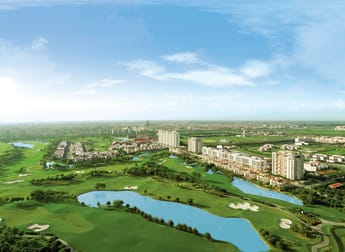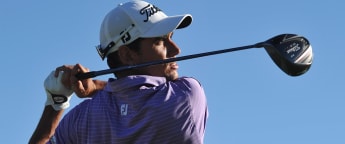If there is one man who knows the magnificent Majlis Course at Emirates Golf Club better than most, it is Barry Lane, a veteran of all 23 previous Omega Dubai Desert Classics. europeantour.com caught up with the Englishman to get his experienced view on the layout’s changes and challenges…

The oldest of all the events that make up The European Tour’s annual Desert Swing, having been contended at the Emirates Golf Club since its inception in 1989, the Dubai Desert Classic has always produced great winners, from Seve Ballesteros to Tiger Woods to Rory McIlroy and, last year, Spain’s Rafa Cabrera-Bello.
Opened in 1988 and designed by Florida-based architect Karl Litten, the Majlis Course, which this week is playing at 7,316 yards to a par of 72, was the first all-grass golf course in the Middle East when it was first built on what was then the very edge of Dubai.
The course features hundreds of indigenous species of flora and fauna, beautifully complemented by meandering fairways and seven fresh and saltwater lakes that come into play on ten holes.
Lane, whose best finish was third place 20 years ago, is back in Dubai on a sponsor’s invite and the five-time European Tour winner clearly has a great affinity with the place.
“It’s incredible,” he said before his 24th appearance in the Dubai Desert Classic. “When I first played here in 1989, the Emirates Golf Club was right out in the desert and now – as you see with the skyscrapers all around it – it’s right in the middle of town.”
Overview
“It’s changed an awful lot over the last 24 years, mainly in the length of the course. There are new tees nearly everywhere but it’s still basically the same golf course; the same design, doglegs left and right, and the same way you have to approach it in just trying to plot your way around.
“The guys these days hit the ball such a long way and it normally is regarded as a long hitter’s course, but then you saw in 2010 with Miguel [Angel Jimenez] winning, who doesn’t hit the ball as long as everybody else, the tournament can be won by hitting fairways.
“It’s got to be at least 500 yards longer now than it was in 1989, though. I’m a lot older, but I remember being able to reach the par fives and now – except for 13 round the corner and 18 if it’s playing downwind – I can’t get close. I probably hit the ball the same distance I used to hit it, it’s just everyone else has got longer!”
Fairways
“There’s very much a premium on finding the fairway from the tee. If you can do that then you have a chance of stopping your ball on the greens, if you miss them then you’re going to struggle.
“A lot of the guys take off the corners of the doglegs so they are hitting very short irons in but they are playing out of the rough. Now for me, if you have a choice of 120 yards out of the rough or 170 yards off the fairway, I would probably choose 170 from the fairway because then you have the control of stopping the ball.
“They are reasonably generous, though, so if you are driving well it is a huge bonus round here. The only problem is because so many of them are doglegs you are running out on the end of them so you have to shape the ball with the contours of each specific hole and with that the fairways become a little bit wider. The rough isn’t too penal if you are only hitting a wedge, but if it’s a four or five iron then it’s impossible.”
Greens
“There are some new collars on the greens and a lot more run-off areas this year. They are quite small greens and without too many tiers but the borrows are subtle and some of them are very long, up to 40 or 50 yards and narrow. It gets harder as the week goes on as they get firmer and the ball will run and run on them.”
Key Holes
“I think it is actually some of the par fours that are key on the Majlis Course. Thesixth(485-yard par four),ninth(463-yard par four) and the12th(467-yard par four) are huge; if you can play those in level par over the week then you will probably gain four shots on the field just on those holes.
“Six is so long, with a narrow green around eight yards wide and 50 yards long. The shorter hitters will be going in with a rescue club around 220 yards to the green and the longer hitters around six or five iron so not an easy approach by any means.
“At nine, length off the tee doesn’t make much difference as 320 yards down you’ll run into the water, so everyone will be going in with six iron there into a very tough green with water on the left and sand on the right.
“Twelve is a good driving hole. If you hit the fairway then you have a chance with a six or seven iron but that’s if you can hit the fairway.”
Conclusions
“It’s a great test. Usually if you look at the scoring the cut is often one or two under par with the leaders at 12 or so after two rounds, with the winning score often coming around 14 under par. It gets harder as the week goes on as the course and the greens get firmer.”
How it played last year
In the 2012 edition of the Dubai Desert Classic, Cabrera-Bello set the winning total at 18 under par, a score that was launched by a fabulous nine under par 63 in the first round.
As Lane suggests, the par four ninth hole – at 463 yards – is a pivotal stop point on the Majlis Course and ranked the most difficult last year at 4.29 with only a measly 42 birdies conceded over four rounds in 2012, while there were 90 bogeys and 33 double bogeys or worse.
At the other end of the spectrum, the par five 13th – at 550 yards – was the hole most taken advantage of in last year’s tournament, yielding 18 eagles and 211 birdies.








